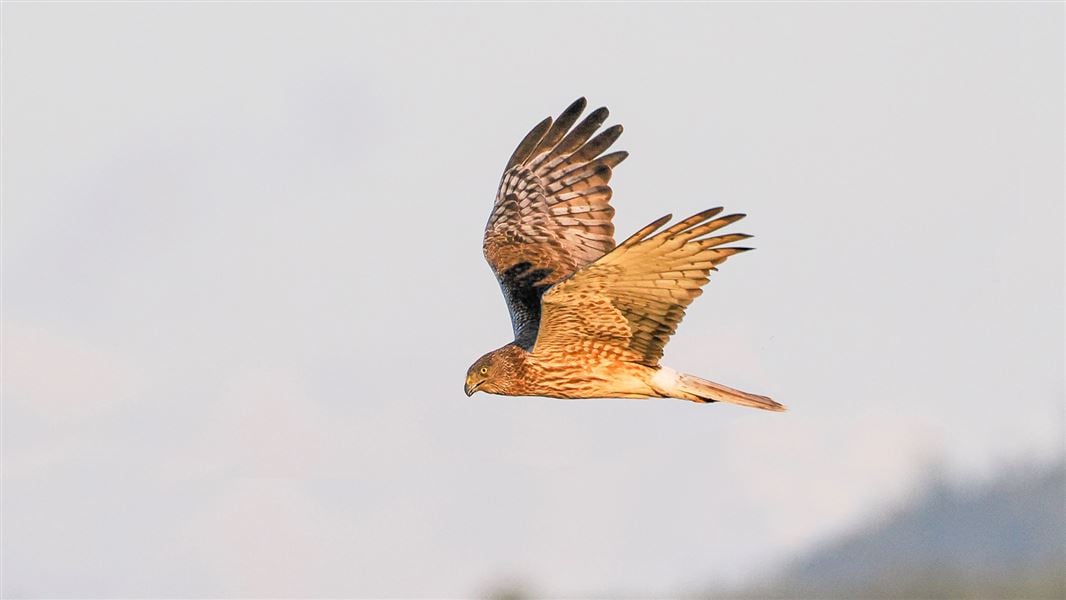Archived content: This media release was accurate on the date of publication.
Date: 19 December 2024
While this common native bird, found throughout Aotearoa, is known to disperse over large areas, its journey hasn’t been GPS-tracked and documented until now.
The adult male left Whangamarino Wetland on 26 September, soared across Cook Straight at heights of 300 m and flew down the eastern South Island to arrive in Middlemarch on 7 October, where he has stayed put.
DOC is monitoring kāhu as part of research to better understand how this bird of prey uses the environment and interacts with threatened native bird species, which it sometimes preys on.
DOC Technical Advisor Thomas Emmitt says kāhu prey on a range of threatened species such as Australasian bittern/matuku-hūrepo and black-fronted tern/tarapirohe.
“However, we don’t know the extent to which kāhu impact threatened species populations. This research will help us understand whether we need to further protect these species from kāhu as part of wider conservation efforts.
“By tracking harriers, we hope to understand how much time they spend foraging around places where vulnerable native species live compared with farmland or other areas, and whether it’s just individual birds that pose a threat or kāhu more widely.”
The early results are exciting, says Thomas. “We’ve seen an adult male take a one-way trip covering 1600 km from Whangamarino to Middlemarch where he may have paired up to breed.
“We’ve also seen a young female fly 150 km between the St James Conservation Area and Hororata in Canterbury three times in just over a month. She seems to have settled in Hororata for now.”
It’s thought these birds are dispersing to new territories. Further monitoring will show whether they stay in these locations.
Other tagged kāhu are staying more local and their flight paths show a criss-cross of movements and habitat uses. The GPS tracking records finer-scale movements than previous studies and it’s hoped that analysis of this data will help shed light on kāhu interactions with threatened native species.
DOC is undertaking the kāhu research in the Waikato where there are bittern, and Clarence River where there are black-fronted tern. Both are critically endangered.
Other threatened species preyed on by harriers include shore plover/tūturuatu/tchūriwat’, fairy tern/tara iti, banded dotterel/tūturiwhatu, Chatham Island oyster catcher/tōrea, kōkako, brown teal/pāteke, marsh crake/koitareke, black stilt/kakī and New Zealand dotterel/tūturiwhatu/pukunui.
DOC controls kāhu in some cases to protect threatened birds such as kakī/black stilt and other braided river birds in the Tasman valley, and tara iti/NZ fairy tern in Northland.
- Kāhu/Australasian harrier's southerly journey map 26 September to 7 October 2024 (PDF, 1,894K)
- Kāhu/Australasian harrier's movements map 15 October to 12 November 2024 (PDF, 2,279K)
Background information
Australasian harrier/kāhu is a common native bird found throughout New Zealand including coastal areas, wetlands, pine forest, farmland and high-country areas.
Self-introduced to New Zealand about 1000 years ago, harriers have thrived in a modified environment and with the introduction of rabbits, hares, mice and birds like sparrows and blackbirds.
Kāhu prey on small to medium-sized birds and mammals, insects, lizards and frogs. They also scavenge road-kill carrion, which can contribute significantly to their diet, especially in winter.
Harriers are partially protected under the Wildlife Act. It is legal to control birds to support the conservation of fully protected wildlife, or to protect domestic or game birds.
Contact
For media enquiries contact:
Email: media@doc.govt.nz
